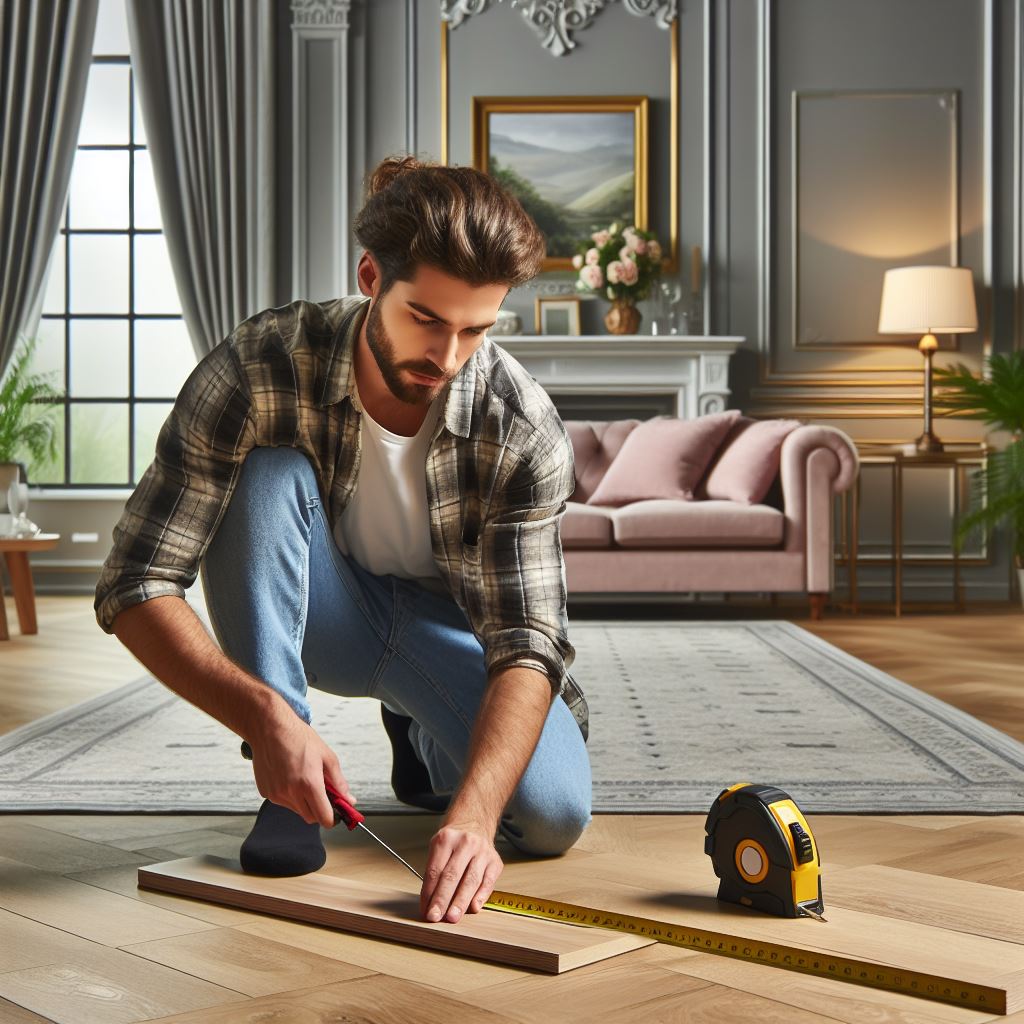Welcome to the journey of transforming your space with the elegance of engineered wood flooring. At Paradise Spaces, we understand the importance of a meticulously installed floor that's not only aesthetically pleasing but also enduring. Before delving into the best way to install engineered wood flooring, let's establish what sets engineered wood apart. Unlike solid hardwood, engineered wood consists of a top layer of hardwood veneer adhered to multiple layers of plywood or high-density fiberboard. This construction provides enhanced stability and resistance to humidity changes, making it an excellent choice for the varying climate of Dallas Fortworth.
Whether you're a DIY enthusiast or seeking professional installation, knowing the optimal techniques is crucial for a flawless finish. Engineered wood flooring offers versatile installation options including gluing, nailing, stapling, or floating. Each method has its advantages and suitability depending on your subfloor and personal preferences. Exploring the best practices ensures longevity and maximizes the beauty of your flooring investment.
If you're ready to elevate your home with stunning engineered wood floors, request a free estimate or email us at sales@paradise-spaces.com. Our team of experts at Paradise Spaces is dedicated to guiding you through every step of your flooring journey, ensuring satisfaction from selection to installation.
Assessing Your Space for Engineered Flooring

Before embarking on the installation process, a thorough assessment of your space is imperative. The condition and type of your subfloor play a pivotal role in determining the best way to install engineered wood flooring. It's essential to ensure that the subfloor is clean, dry, and level to provide a stable foundation for your new floors. Discrepancies in subfloor levelness can lead to uneven wear, creaking sounds, and potential damage to the engineered wood planks.
It's also crucial to measure the moisture content of your subfloor using a moisture meter. Engineered wood, while more resistant to moisture than solid hardwood, can still be susceptible to excessive moisture levels. Ideal moisture content levels can vary, but generally, a reading of 6-9% is considered safe for most engineered wood products. Another aspect to consider is the room's climate; consistent temperature and humidity levels will maintain the integrity of your flooring over time.
Additionally, take into account the direction in which the planks will run. Ideally, they should run perpendicular to the floor joists to ensure maximum support and stability. The direction can also impact the visual perception of the space; planks running lengthwise can make a room appear longer, while those laid widthwise can make it seem wider.
By meticulously assessing your space, you safeguard the longevity of your flooring and ensure that the end result is both functional and fetching. A well-prepared base is the foundation for a successful engineered wood flooring installation that you will enjoy for years to come.
Choosing the Right Tools and Materials

Selecting the correct tools and materials is a crucial step in ensuring a smooth and efficient installation of engineered wood flooring. To begin with, you'll need a high-quality saw, as precision cutting is fundamental to achieving a professional look. A table saw or a miter saw can provide the accuracy needed for cutting planks to size, especially for intricate areas around corners or doorways.
Another essential tool is a flooring nailer or stapler, which is specifically designed for engineered wood floors. This will expedite the installation process and help achieve a secure fit. For glue-down installation methods, an appropriate adhesive and a notched trowel are indispensable to evenly spread the glue and firmly bond the flooring to the subfloor.
Don't underestimate the importance of spacers, which are used to maintain an expansion gap around the perimeter of the room. This gap is vital as it allows the wood to expand and contract with changes in humidity without causing buckling. Additionally, a tapping block and a pull bar will assist in gently nudicing the planks into place without damaging the edges.
It's also wise to invest in knee pads for comfort and a set of safety glasses for protection. Remember that the best way to install engineered wood flooring is not just about the technique but also about using the right materials, such as high-quality underlayment, which can provide sound dampening and moisture resistance.
In summary, gathering all necessary tools and materials in advance will streamline the installation process, helping you achieve a flawless finish. A well-equipped installer is prepared to tackle any challenge that comes their way during the installation of engineered wood flooring.
Step-by-Step Guide to Laying Engineered Wood Planks

Laying engineered wood planks is a methodical process that, when done correctly, results in a stunning and long-lasting floor. First, ensure that the subfloor is clean, dry, and level. Any high spots should be sanded down and low spots filled with a leveling compound. Begin by laying out the planks to visualize the floor pattern and to determine plank arrangement considering the room's shape and the wood grain.
Start the installation from the longest wall and proceed with the first row, using spacers to maintain the expansion gap as per manufacturer's guidelines. Apply a bead of adhesive if using the glue-down method, or position the planks to be nailed or stapled down. When you reach the end of the first row, cut the last plank to fit, and use the leftover piece to start the next row, ensuring the joints are staggered at least six inches for structural integrity and aesthetic variety.
Continue with subsequent rows, tightly locking the tongue and groove joints together using a tapping block or a pull bar for hard-to-reach areas. Regularly check for gaps and alignment, using a soft mallet to adjust the planks as necessary. It's essential to maintain the expansion gap on all sides of the room throughout the installation.
After laying the final row, which may need to be trimmed lengthwise to fit, remove all spacers and install baseboards or quarter-round molding to cover the expansion gaps. This also provides a clean and finished look to the room's perimeter. Once the installation is complete, it is critical to allow the floor to settle, avoiding heavy furniture placement for at least 24 hours.
This step-by-step guide emphasizes the best way to install engineered wood flooring, ensuring a flawless finish that will last for years to come. Remember that precision and patience during the installation process are key to achieving the desired outcome.
Finishing Touches for Engineered Flooring Installation

Once the engineered wood planks are securely laid, it's time to apply the finishing touches that will elevate the look and longevity of your flooring. Begin by thoroughly cleaning the surface of any debris, sawdust, or adhesive residue that may have been left behind during the installation process. Vacuuming and gently wiping the floor with a damp cloth can ensure a pristine base for further finishing.
Installing transition strips at doorways and thresholds is crucial for a smooth transition between different flooring types or levels. These not only enhance safety by reducing tripping hazards but also provide a cohesive look throughout your home. Choose a strip that complements the color and style of your engineered wood for the best visual appeal.
Sealing the edges of the floor, especially near wet areas such as kitchens and bathrooms, adds an extra layer of protection against moisture penetration. A silicone sealant can be used to fill any gaps, preventing water damage and warping over time. Additionally, applying a final finish coat, whether it be oil or polyurethane-based, can offer added durability and ease of maintenance. Make sure to follow the manufacturer's recommendations for the appropriate finish to use.
Finally, reattach or replace the baseboards and shoe moldings that frame your room. These not only hide the expansion gap but also add a polished look to your installation. When nailing them in place, take care to nail into the wall and not the floor to allow for natural wood movement.
With these finishing touches, your engineered wood flooring installation will not only look professional but also stand up to daily use, retaining its beauty and functionality for years to come.
Maintaining Your Engineered Wood Floors Post-Installation
After the installation of your engineered wood flooring, proper maintenance is key to preserving its appearance and extending its lifespan. Start by placing protective pads under furniture legs to prevent scratches and dents on your new floors. It's also advisable to use rugs in high-traffic areas to minimize wear and tear. When it comes to cleaning, use a soft-bristled broom or a vacuum with a hardwood floor attachment to remove dirt and grit that could potentially scratch the surface.
Avoid using excessive water or steam mops, as moisture can damage engineered wood. Instead, opt for a damp mop with a cleaner that is specifically formulated for engineered wood floors. Spills should be wiped up promptly to prevent water marks or damage. Moreover, keeping the indoor humidity levels consistent can help prevent the wood from swelling or shrinking, which could lead to gaps or buckling.
For deeper cleans or when the floor begins to look dull, a professional refinish may be in order. Although engineered wood can't be sanded down as many times as solid hardwood, it can still be refinished a few times depending on the thickness of the top layer. This process can refresh the look of your floors and address any minor damage that has occurred over time.
To ensure your floors stay in pristine condition, consider scheduling regular professional cleanings or inspections. If you're unsure about the best practices for maintaining your engineered wood flooring, request a free estimate or email us at sales@paradise-spaces.com. Our experts at Paradise Spaces are committed to helping you enjoy your beautiful floors for as long as possible.
